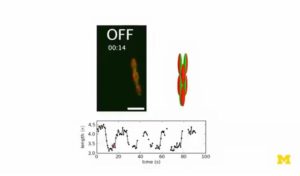ANN ARBOR — In a step toward robots smaller than a grain of sand, University of Michigan researchers have shown how chains of self-assembling particles could serve as electrically activated muscles in the tiny machines.
So-called microbots would be handy in many areas, particularly medicine and manufacturing. But several challenges lie between current technologies and science fiction possibilities. Two of the big ones are building the ‘bots and making them mobile.
“We are inspired by ideas of microscopic robots,” said Michael Solomon, a professor of chemical engineering. “They could work together and go places that have never been possible before.”
Solomon and his group demonstrated that some gold plating and an alternating electric field can help oblong particles form chains that extend by roughly 36 percent when the electric field is on.
“What’s important in the field of nanotechnology right now is not just assembling into structures, but assembling into structures that can change or shape-shift,” said Sharon Glotzer, the Stuart W. Churchill Professor of Chemical Engineering, whose team developed computer simulations that helped explain how the chains grew and operated.
The innovation that led to the shape-shifting, said Aayush Shah, a doctoral student in Solomon’s group, is the addition of the electric field to control the behavior of the particles.
“The particles are like children in a playground,” Shah said. “They do interesting things on their own, but it takes a headmaster to make them do interesting things together.”
The team started with particles similar to those found in paint, with diameters of about a hundredth the width of a strand of hair. They stretched these particles into football shapes and coated one side of each football with gold. The gilded halves attracted one another in slightly salty water—ideally about half the salt concentration in the sports drink Powerade. The more salt in the water, the stronger the attraction.
Left to their own devices, the particles formed short chains of overlapping pairs, averaging around 50 or 60 particles to a chain. When exposed to an alternating electric field, the chains seemed to add new particles indefinitely. But the real excitement was in the way that the chains stretched.
“We want them to work like little muscles,” Glotzer said. “You could imagine many of these fibers lining up with the field and producing locomotion by expanding and contracting.”
While the force generated by the fibers is about 1,000 times weaker than human muscle tissue per unit area, it may be enough for microbots.
“If we can get the chains to swarm together, we can get them to lift loads, move around, do things that biological muscles do,” Solomon said.
Minuscule, muscled robots may be many years away, but more immediately, the particles could enable electronics that rewire on demand.
“These chains are essentially wires, so you could assemble them into a circuit for reconfigurable electronics,” said Solomon.
The team is still investigating how the phenomenon works.
“We don’t fully understand why the chains extend, but we have some ideas,” said Benjamin Schultz, a graduate student in Glotzer’s group.
The study, appearing in the journal Nature Materials, is titled “Actuation of shape-memory colloidal fibres of Janus ellipsoids.” The research was supported by the U.S. Army Research Office, and the Assistant Secretary of Defense for Research and Engineering, U.S. Department of Defense.
Solomon is also a professor of macromolecular science and engineering. Glotzer is also a professor of materials science and engineering, macromolecular science and engineering, physics and applied physics. Both are core faculty of the Biointerfaces Institute.
– By Nicole Casal Moore
*Source: University of Michigan

